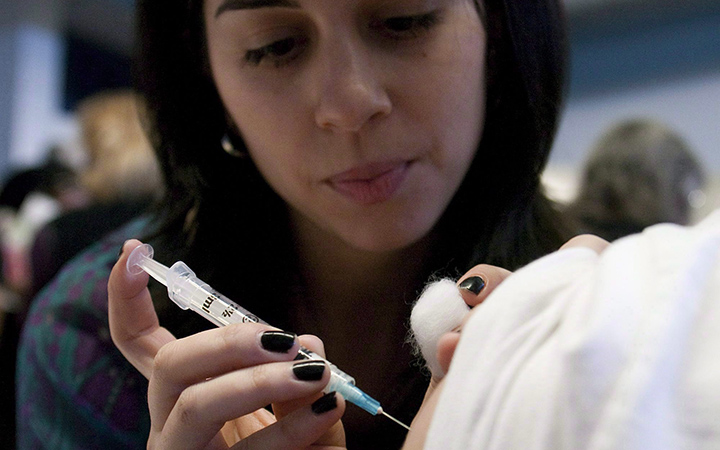TORONTO – Thousands of Ontario students face suspensions from school because they haven’t provided updated immunization records, but public health officials can’t say exactly how many young people across the province are affected.

The 36 local public health units in Ontario are required to maintain immunization records for school pupils, and can ask boards to issue suspension warnings to parents in an effort to get them to make sure their children’s vaccines are up to date.
School boards in Toronto, Ottawa, North Bay, Hamilton, Brampton and other communities have either sent warnings to parents about possible suspensions if updated immunization records were not provided, or moved with the local health unit to suspend students.
Toronto Public Health says the Toronto District School Board suspended 3,947 high school students in 2012-13 and 6,626 elementary students in 2013-14 for not having updated immunization records. About 1,800 students at schools in Ottawa have been suspended since mid-December for the same reason.
READ MORE: Ontario proposes tougher rules for exempting school kids from vaccinations
Public Health Ontario, an agency set up by the Liberals in 2007 to, among other things, monitor the percentage of Ontarians who receive vaccines, said it does not collect the student immunization records from local public health units.
“There is no one central place where all that information is available,” said agency spokeswoman Janet Wong.
- Life in the forest: How Stanley Park’s longest resident survived a changing landscape
- ‘They knew’: Victims of sexual abuse by Ontario youth leader sue Anglican Church
- Carbon rebate labelling in bank deposits fuelling confusion, minister says
- Buzz kill? Gen Z less interested in coffee than older Canadians, survey shows
The Ministry of Health said a five-year renewal plan for its immunization program released last month will look at ways to improve public reporting of student immunization rates.
“Ontario will be proposing changes to the Immunization of School Pupils Act that, if passed, would include stronger requirements for school vaccine exemptions, as well as look at ways to improve public reporting on local vaccine coverage rates,” said Shae Greenfield, press secretary to Health Minister Eric Hoskins.
Often the vaccines are up to date but not the actual immunization records because some boards update the data immediately following school-based clinics, while others wait until the end of the school year to file it with the public health unit.
READ MORE: Whooping cough outbreak at elementary school in London, Ont.: health unit
Ontario’s auditor general criticized the government’s lack of information on its vaccine programs in her 2014 annual report, saying the data are often far out of date depending on when schools, and parents, report the vaccinations.
The New Democrats said there is already a growing problem with some parents disputing the validity of vaccines who don’t want to have their kids immunized, and warned that not having an accurate way to track vaccination rates will add fuel to their arguments.
“This is a really bad situation made worse by the government’s inability to bring in an electronic health records system,” said NDP health critic France Gelinas. “That $1 billion wasted on eHealth would have counted every kid with or without an immunization record and gold plated it on the front of every health unit and every school.”
Every time a student gets a vaccine there should be an electronic record sent to the local public health unit instead of giving them a piece of paper, which often gets lost before it’s turned in or is misread as someone attempts to manually upload the data, added Gelinas.
READ MORE: HPV vaccine Gardasil safe; no evidence of serious adverse effects: Health Canada
“We have increasing members of our population who are losing faith in vaccinations, and when the system doesn’t work, they lose faith in the whole thing,” she said.
Public Health Ontario’s report for the 2012-13 school year found the number of seven-year-olds granted an exemption because of religious or conscientious objections ranged from 1.3 per cent for mumps and rubella to two per cent for the polio vaccine.
“Although the overall proportion of students registering exemptions at the provincial level is relatively low, it obscures the geographic clustering of exemptions that is well recognized,” said the report.
It also found immunization coverage rates varied greatly by vaccine and by age groups, and suggested some communities and students may be at increased risk of certain vaccine-preventable diseases.



Comments